

Needed Tools: Each connector brand requires a different toolset.And if you’re wiring a lighting system, you can find connectors that can attach more than three wires. You can also find T-tap connectors for connecting three wires. There are tube-type connectors for connecting two wires only. Types of Connectors: There are different types of connectors available in the marketplace.So to ensure the safety of your project, the connector brand you choose should have complied with and is certified by multiple product safety organizations. These items are designed to work with high voltages-as such, they should withstand the power and heat coursing through them. Compliance With Product Safety Standards: One of the first things you should look for in a wire connector is its compliance with product safety standards.WireTwist® - an economical connector similar to the Wire- Nut. Wing- Nut® - these have contoured wings to provide a secure grip and extra torque. Wire- Nut® - the original wire connector, available in five sizes. If you need to remove this wire connector, it should be replaced with a new wire connector because of the expansion. The shell expands when tightening to ensure a secure connection. This is also very commonly used for commercial construction. Twister® - IDEAL considers this the most common wire connector for residential projects. Avoid using the minimum and maximum sizes and numbers. Wire connectors packages show the minimum and maximum wires and sizes allowed. Wire connector size depends upon the wire gauges and number of wires connected together. Ideal Wire Connector Brochure - A complete guide of their wire connector products. Ideal Wire Range Chart - A two page quick reference for matching wire size, number of wires, and wire connector color code. Twist- on wire connectors are available in many different color- coded sizes to allow for different wire gauges and number of wires. IDEAL Industries brand twist- on wire connectors are the most commonly used and will be featured in this article. There are many types of wire connectors, the most common are twist- on. Wire connectors are used to connect two or more wires together. Connector colors and sizes are are not the same within the industry, but they are similar to IDEAL’s connectors. IDEAL Industries provides information on their wire connectors including connector color coding that indicates size. IDEAL Industries first wire connector was called wire- nut®, and had become the trade name for any twist- on wire connector. If the wires in a junction box with push- in connectors need to be modified, the wires in these connectors will probably need to be cut and reconnected with twist- on connectors. Never use push- in connectors in an electrical junction box. Light fixtures use 18 AWG wires which are easy to remove from these connectors by pulling and twisting the wires. They should only be used in light fixtures. It is very easy to connect wires into push- in connectors, but are a major pain to disconnect. Another size connector may be needed to make a proper connection. If it does not stop twisting or if a wire comes loose when pulling in step 6, undo the connection and start over again.

The connector should stop twisting after step 5. Lightly pull on each wire to ensure the wires are secured inside of the connector.Insert wires into connector and screw on clockwise until the connector stops twisting.Lead stranded wire(s) beyond the solid wire(s) by about 1/16 inch(1.6mm). Strip about ¾ to 1 inch for more than two wires. Strip wires, usually about ½ inch for two wires.The image to the right is of garage door opener wiring connected with telephone wire butt splice connector. A pliers or crimping tool can be used to squeeze the top and bottom of the connector together to make the connections. These wires are stripped (or not, see instructions) and inserted into the connectors. Butt splice connectors are used to connect two or more wires together.

These wires are used for telephone, computer data, and garage door opener wiring and are to be used for low voltage only. Data and phone wires are very small in diameter at 22 to 24 AWG.


 0 kommentar(er)
0 kommentar(er)
